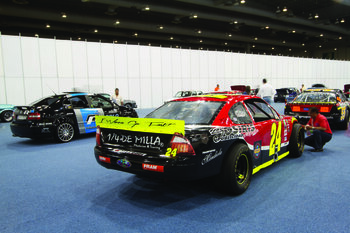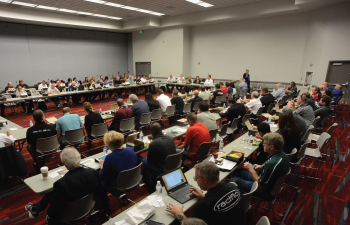SEMA News—October 2020
INTERNATIONAL
The New United States-Mexico-Canada Agreement
Tips on How to Qualify for the Lowest Tariff Rates
 USMCA replaced the North American Free Trade Agreement (NAFTA) effective July 1, 2020. All claims for lower tariff rates for exports to Canada and/or Mexico will need to be made using the new requirements called for under USMCA instead of NAFTA. Pictured here: A Canadian off-road distributor speaks at SEMA headquarters about the export opportunities in Canada during the 2019 Export Fair. USMCA replaced the North American Free Trade Agreement (NAFTA) effective July 1, 2020. All claims for lower tariff rates for exports to Canada and/or Mexico will need to be made using the new requirements called for under USMCA instead of NAFTA. Pictured here: A Canadian off-road distributor speaks at SEMA headquarters about the export opportunities in Canada during the 2019 Export Fair. |
SEMA News appreciates the assistance of the U.S. Department of Commerce’s International Trade Administration and the U.S. Customs and Border Protection (CBP) in shedding light on the key provisions of the new trilateral trade agreement. The USMCA replaced the North American Free Trade Agreement (NAFTA), which had been governing regional trade since 1994.
What is the status of NAFTA?
USMCA replaced NAFTA effective July 1, 2020. All claims for lower tariff rates will need to be made using the new requirements called for under USMCA instead of NAFTA.
What are the new automotive rules of origin under the USMCA (the requirements a company must meet in order to claim preferential treatment)?
The automotive rules of origin for vehicles under the USMCA include several key components:
- An overall regional content requirement (75% for passenger vehicles and light trucks).
- A requirement that certain core parts (such as engine, transmission, body and chassis, axle, suspension system, steering system and advanced battery) must originate in North America.
- Purchasing requirements for steel and aluminum in North America.
What about automotive aftermarket parts? Are manufacturers of specialty-equipment products required to meet the same multilevel rules of origin involving specific requirements (such as those governing labor value content and the origin of core parts and the steel and aluminum involved in the manufacturing of the product)?
Generally, no. USMCA defines an “aftermarket part” as “a good that is not for use as original equipment in the production of passenger vehicles, light trucks or heavy trucks.”
The new and complex origin requirements (outlined above) apply only to passenger vehicles, light trucks, heavy trucks and original-equipment parts. The regional value content requirement for aftermarket parts is typically less stringent than that for original-equipment parts and whole vehicles.
Aftermarket parts typically are required to satisfy a singular minimum RVC requirement, generally 50% to 60% under the net cost method. For additional information on the differing treatment of whole vehicles, OEM parts and aftermarket parts, refer to Section 13 of the USMCA uniform regulations (www.federalregister.gov/d/2020-13865/p-995).
Do the automotive rules of origin apply to exported vehicles that are primarily used off-road?
No. Producers and shippers of vehicles that are solely or principally for off-road use are not subject to the core parts, labor value content, or steel and aluminum purchase requirements. However, exporters of those products should refer to the product-specific rules of origin to find the regional value content requirement specific to their vehicle by its Harmonized System (HS) code. Such vehicles are defined as those that do not meet U.S. federal safety and emissions standards permitting unrestricted on-road use or the equivalent Mexican and Canadian on-road standards.
My specialty-equipment products are not required to meet the Automotive Rule of Origin requirements. How do I find out what minimum content I am required to meet and what the tariff rates are for my products?
There are a few steps required to determine the correct tariff code for your products:
- In order to export to Canada or Mexico, you need to know the global product classification (HS code), as you would for any other global destination. Customs authorities around the world use the HS code to identify products when assessing duties and taxes. The United States uses a 10-digit code to classify products for export, known as a Schedule B number. Visit https://uscensus.prod.3ceonline.com for the online free “look-up feature” Schedule B search engine and to view the Census Bureau’s Export Training Video on how to classify your product.
- Once you know the HS code applied to your product, you can use the Federal Transit Administration (FTA) Tariff Tool to look up the tariff rate for the product, available at www.export.gov/fta-tariff-tool. (Note: When entering the appropriate HS code using the above link, make sure to enter only numbers and not quote marks.) The FTA Tariff Tool incorporates all products (agricultural and nonagricultural goods) classified within all 97 chapters of the Harmonized System and includes information on product-specific rules of origin to determine the eligibility of the reduced tariff rates with any U.S. FTA partner. The Tariff Tool not only provides information on current tariff lines but also transparency on future tariffs and the year in which those products become duty-free.
The query tool allows you to generate a custom query using your product’s HS code, the FTA partner you’re trading with, and whether you are exporting or importing. Please note that all tariff rates derived from this online tool should be reconfirmed with your shipper or the appropriate customs agency, as they are subject to change.
 Products manufactured and sold to neighboring countries, i.e., Mexico and Canada, are eligible for preferential tariff treatment if they are sold within the region and meet the minimum content requirements as dictated by the new USMCA. Mexicans are big fan of musclecars, both classic and more modern. Pictured here is a section of the PAACE Automechanika show, held annually in Mexico City, that is dedicated to dozens of lovingly restored classic cars. |
My products meet the regional content requirements. How do I document this information in order to claim preferential treatment?
There is no official certificate of origin for USMCA, as there was for NAFTA. USMCA requires a “certification of origin” for all products exceeding $1,000 or the equivalent amount in the importing party’s currency.
Any format is acceptable, provided it contains the following nine minimum data elements set out in USMCA, Annex 5-A:
- Importer, exporter, or producer certification of origin
- Certifier
- Exporter
- Producer
- Importer
- Description and HS classification of the good
- Origin criteria
- Blanket period (if applicable)
- Authorized signature and date
What are the record-keeping requirements for shipments for which I have claimed preferential treatment?
Manufacturers are required to maintain, for a period of no less than five years, all records necessary to demonstrate that a good for which the exporter or producer provided a certification of origin or other written representation is originating, including records associated with (a) the purchase of, cost of, value of, shipping of, and payment for, the good or material; the purchase of, cost of, value of, shipping of, and payment for all materials, including indirect materials, used in the production of the good or material; and the production of the good in the form in which the good is exported or the production of the material in the form in which it was sold.
My aftermarket products are manufactured with 92% U.S. content and an estimated 8% Chinese content. Can I mark my products “U.S. Content” rather than listing both countries of origin?
The USMCA clarifies that most goods can be marked with a single country of origin even if up to 10% of the components do not originate in that country. If more than 10% of the components are nonoriginating, the good must be marked with multiple countries of origin.
Under CBP’s previous NAFTA marking regulations, sets had to be marked with “the country or countries of origin of all materials that merit equal consideration for determining the essential character of the good.” While subject to certain exceptions, the new rule gives importers more certainty as to how sets should be marked with the country or countries of origin.
Products manufactured and sold within North America are eligible for preferential tariff treatment if they meet minimum content requirements as dictated by the new U.S.–Mexico–Canada Agreement (USMCA). This article answers questions SEMA News has received from SEMA-member companies about the details of the regulations under the new agreement, which took effect July 1, 2020, and the documentation required when exporting your products to Canada and Mexico.
| Part | HS Code |
| Intake Air Filters for Internal Combustion Engines | 8421 |
| Seats of a Kind Used for Motor Vehicles | 9401 |
| Camshafts and Crankshafts | 8483 |
| In order to export to Canada or Mexico (as you would for any other global destination) you need to know the global product classification known as the Harmonized System (HS) code. The HS code is used by customs authorities around the world to identify products when assessing duties and taxes. Typically, automotive specialty products and accessories for such vehicles are classified in Chapter 87 of HS system. Within this chapter, most of the HS codes for specialty products fall between 8701 to 8705. However, there are numerous exceptions,s including the parts listed above. |
More information on the USMCA agreement and other exporting best practices are available online at www.sema.org/international or by contacting SEMA Senior Director of International and Government Relations Linda Spencer at lindas@sema.orglindas@sema.org.








